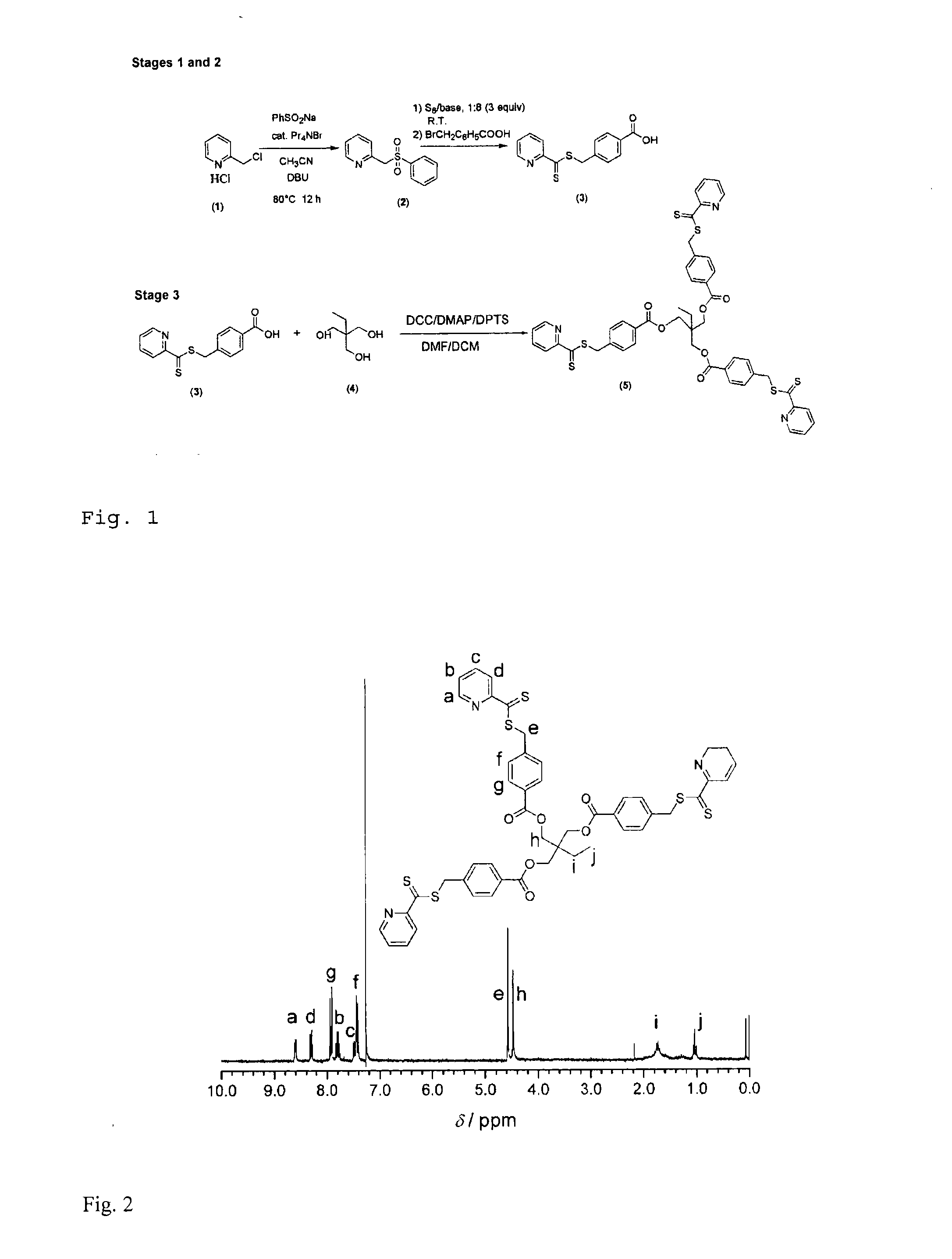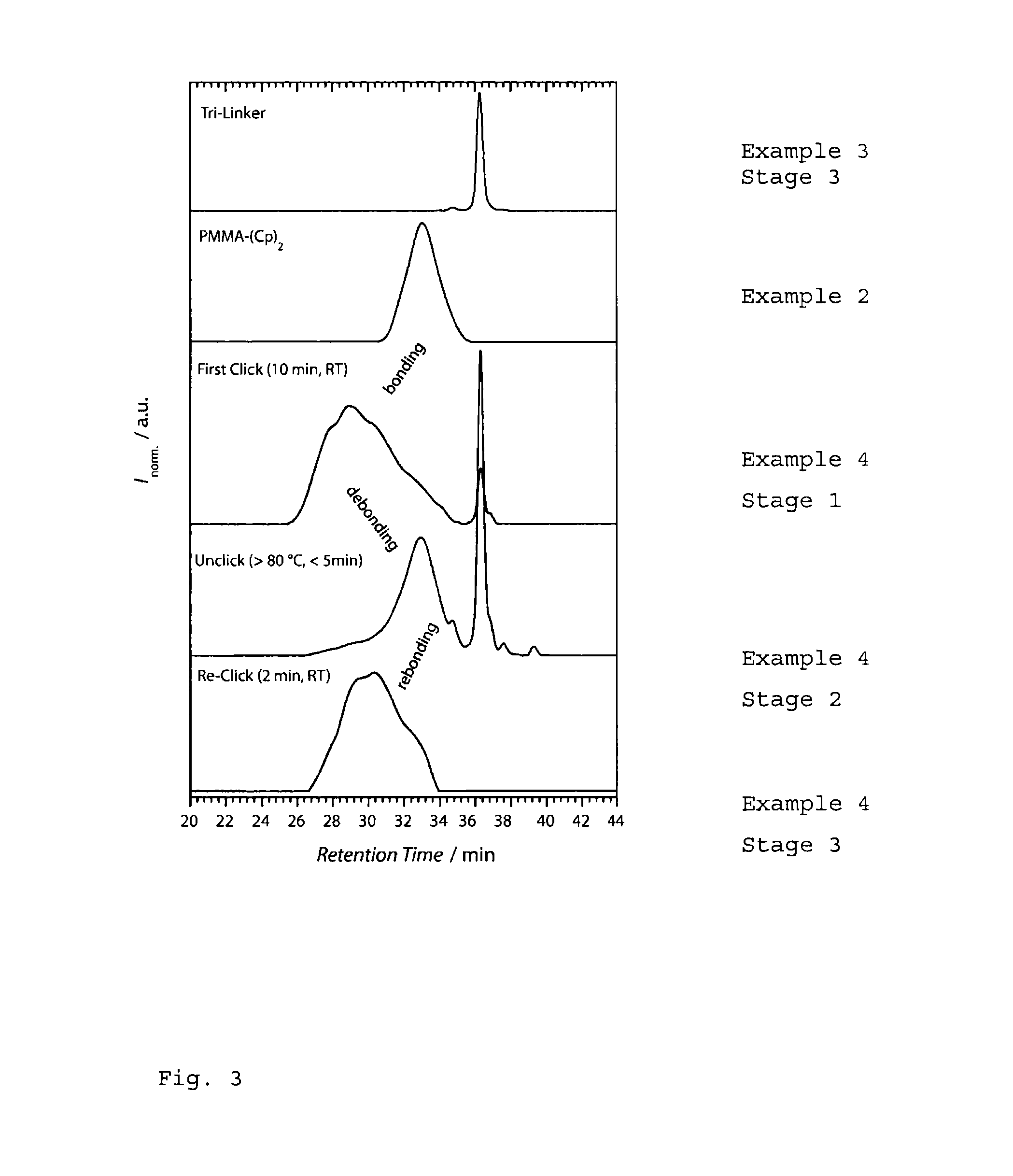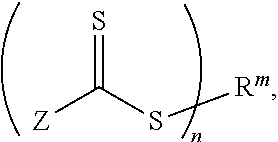Functional materials with reversible crosslinking
a crosslinking and functional technology, applied in the direction of polyester coatings, coatings, inks, etc., can solve the problems of reducing the adhesive bonding effect sufficiently to part the bond, the two-layer structure is laborious to construct, and the process is irreversibl
- Summary
- Abstract
- Description
- Claims
- Application Information
AI Technical Summary
Benefits of technology
Problems solved by technology
Method used
Image
Examples
example 1
Synthesis of bis(bromo)polymethyl methacrylates
[0042]50 equivalents of methyl methacrylate (MMA), 1 equivalent of 1,2-bis(bromoisobutyryloxy)ethane, 0.105 equivalent of copper(I) bromide, 0.0125 equivalent of copper(II) bromide and 0.25 equivalent of 2,2′-bipyridine are placed in a 1 l three-neck flask with magnetic stirrer, nitrogen inlet and reflux condenser. Acetone is added to the mixture in an amount sufficient to give 500 ml of a 50% strength (by volume) solution. Oxygen present is removed by passing nitrogen through the solution for 40 minutes. The mixture is then heated to 50° C. in an oil bath under nitrogen. Polymerization is terminated after 2 hours by cooling in an ice bath and admission of atmospheric oxygen. The copper catalyst is removed by filtration on a short column packed with neutral alumina. The bromine-terminated poly(methyl) methacrylate (PMMA-Br2) is precipitated twice from cold hexane, being dissolved in a little acetone in-between. The molecular weight is d...
example 2
Synthesis of bis(cyclopentadienyl)polymethyl methacrylate
[0043]1 equivalent of PMMA-Br2 from Example 1, 12 equivalents of sodium iodide, 4 equivalents of tributylphosphane and 8 equivalents of nickelocene are dissolved in dried tetrahydrofuran (THF) under nitrogen in a 50 ml three-neck flask with magnetic stirrer, reflux condenser and dropping funnel, to form 25 ml of a solution which is 0.1 molar with respect to the polymer. The solution is stirred at room temperature for 12 hours, and the reaction solution is then purified by column chromatography on a short column packed with basic alumina. The cyclopentadienyl-terminated poly(methyl) methacrylate (PMMA-Cp2) is precipitated twice from cold hexane. The double functionalization with cyclopentadienyl groups, which has taken place to an extent of more than 95%, is detected by ESI-MS. The m / z values are in each case approximately 29.6 mol−1 smaller than the measurement for the product from Example 1.
example 3
Synthesis of the Trifunctional Crosslinker
[0044]Stage 1: A solution of 1.64 g (10 mmol) of 2-(chloromethyl)pyridine hydrochloride (1), 2.46 g (15 mmol) of sodium phenylsulfinate, 0.53 g (2 mmol) of tetrapropylammonium bromide and 1.52 g (10 mmol) of 1,8-diazabicyclo[5.4.0]undec-7-ene (DBU) in 10 ml of acetonitrile is stirred under reflux for 12 hours. Then all of the volatile constituents such as the solvent are removed under reduced pressure and the residue is dissolved in a little methylene chloride. The solution is extracted by shaking with sodium chloride solution, dried over magnesium sulphate and filtered and the solvent is removed under reduced pressure. The crude product (2) is obtained in quantitative amounts as a white solid and is used without further purification in the second stage.
Stage 2 (4-((pyridine-2-carbonothioylthio)methyl)benzoic acid hydrochloride) (3a):
[0045]A mixture of 1.9 g (8.51 mmol) of Stage 1 (2) and 0.78 g (24.3 mmol) of sulphur is stirred in 10 ml of ...
PUM
| Property | Measurement | Unit |
|---|---|---|
| temperature | aaaaa | aaaaa |
| temperatures | aaaaa | aaaaa |
| temperatures | aaaaa | aaaaa |
Abstract
Description
Claims
Application Information
 Login to View More
Login to View More - R&D
- Intellectual Property
- Life Sciences
- Materials
- Tech Scout
- Unparalleled Data Quality
- Higher Quality Content
- 60% Fewer Hallucinations
Browse by: Latest US Patents, China's latest patents, Technical Efficacy Thesaurus, Application Domain, Technology Topic, Popular Technical Reports.
© 2025 PatSnap. All rights reserved.Legal|Privacy policy|Modern Slavery Act Transparency Statement|Sitemap|About US| Contact US: help@patsnap.com



